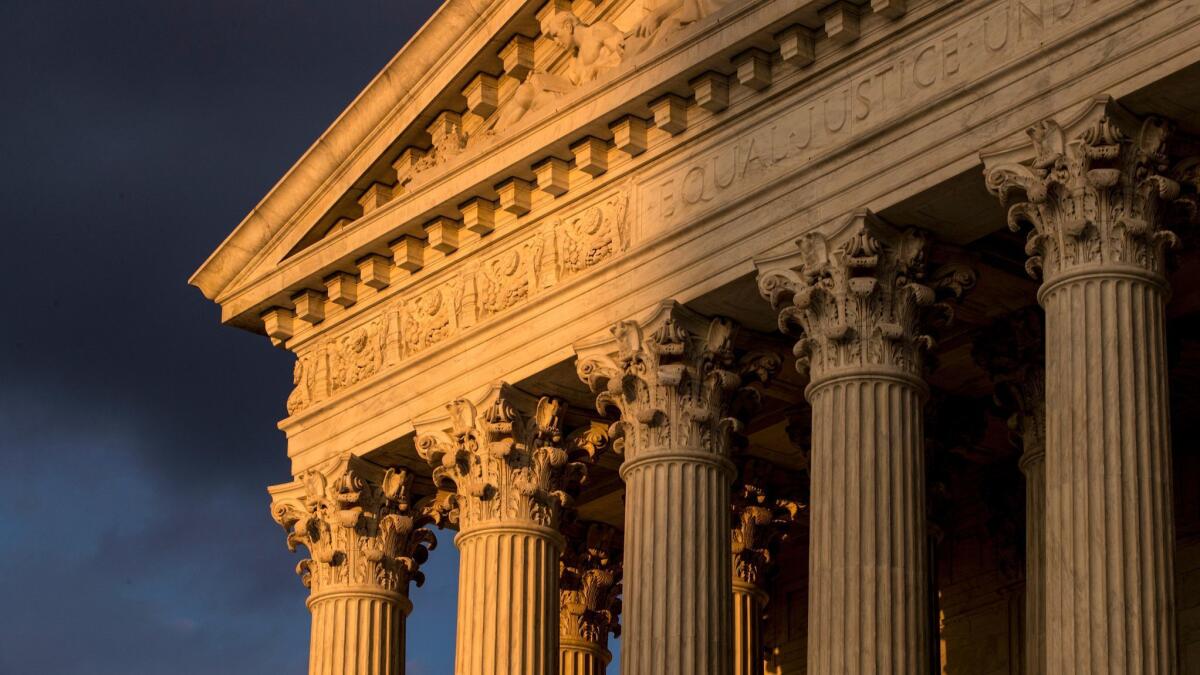Supreme Court makes it easier for states to remove voters from the rolls if they skip an election

Reporting from Washington — The Supreme Court made it easier Monday for states to remove occasional voters from the rolls, upholding an Ohio law that drops voters who fail to cast a ballot and do not respond to several notices.
In a 5-4 decision, the court’s conservative majority agreed with Ohio Republicans who said they sought to “clean up” the voting rolls by purging the names of people who appeared to have moved and left the area. The court said that nationwide, 24 million voter registrations are estimated to be inaccurate or invalid, mostly of people who have moved.
The four liberal justices dissented and said the ruling would allow officials to wrongly eliminate the voter registrations of people who sat out an election or two and did not respond to notices in the mail.
The legal dispute played out against a backdrop where two major parties had opposite views. Republicans spoke of “voter fraud” and election rolls they said were stocked with ineligible and illegal voters, while Democrats complained of “voter suppression” by GOP states which, they said, made it harder for minorities and the poor to cast ballots.
Ohio has gone further than other states in trying to “clean up” its voter rolls, and liberal activists said they feared its model will now be used in other Republican-leaning states.
“Voters should not be purged from the rolls simply because they have exercised their right not to vote. This ruling is a setback for voting rights, but it is not a green light to engage in wholesale purges of eligible voters without notice,” said Dale Ho, director of the ACLU’s Voting Rights Project.
Kristen Clarke, president of the Lawyers’ Committee for Civil Rights Under Law, called the ruling a “disappointing decision, not only because it gets the law wrong, but also because it sends the wrong message to state officials. They must do everything possible to help people vote, not place obstacles in their paths to the ballot box.”
Voter-purge programs have a “long history” of being used “to unfairly and disproportionately target minority voters,” she said.
Ohio Secretary of State Jon Husted called the decision “a victory for election integrity, and a defeat for those who use the federal court system to make election law across the country. This decision is validation of Ohio’s efforts to clean up the voter rolls and now with the blessing nation’s highest court, it can serve as a model for other states to use.”
The Ohio policy is among the most aggressive in the country for removing registered voters who sit out an election or two. Most states remove voters from the rolls only after seeing evidence they have moved or died.
Lawyers for California, New York and Illinois told the court that election officials would remove a voter from the rolls if the Postal Service returned a notice as “undeliverable” or moved with no forwarding address. They may also consult tax records or the Department of Motor Vehicles to see if a resident has moved.
Civil rights lawyers had sued Ohio and argued that tens of thousands of voters in Cleveland and other big cities had been wrongly removed from voting rolls. They won an appeals court ruling that held the state was violating federal law by removing voters simply for a “failure to vote.”
At issue was how to interpret two federal laws that set conflicting goals:
The National Voter Registration Act of 1993, often called the Motor Voter Act, sought to “increase the number of eligible voters who register to vote” and protect the “integrity of the electoral process” by maintaining “accurate and current voter registration rolls.”
The Help America Vote Act of 2002 said states should make a “reasonable effort to remove registrants who are ineligible to vote” by dropping those who skipped elections and did not respond to notices. However, the law also said registered voters should not be “removed solely by a reason of a failure to vote.”
Not surprisingly, judges disagreed on how to read those legal requirements.
A federal judge had upheld Ohio’s procedure because it tracked the federal law. If a voter doesn’t cast a ballot or engage in other “voter activity” such as updating a registration form for two years, the state sends a notice asking for confirmation of eligibility; if the voter doesn’t respond or doesn’t vote in the next four years, he or she is removed from voter rolls.
But the 6th Circuit Court of Appeals agreed with the civil rights plaintiffs and said Ohio triggered its removal process because a registered voter had failed to vote, exactly what the law prohibited.
The Supreme Court took up Ohio’s appeal and upheld the state’s procedures.
Justice Samuel A. Alito Jr. said Ohio “does not strike any registrant solely by reason of the failure to vote. Instead, as expressly permitted by federal law, it removes registrants only when they have failed to vote and have failed to respond to a change-of-residence notice.”
The decision in Husted vs. A. Philip Randolph Institute split the court along familiar lines. Five conservative justices, all Republican appointees, formed the majority; the four liberal Democratic appointees dissented.
Justice Stephen G. Breyer said in a dissent that the state puts too much weight on people who skip one election and fail to respond to notices in the mail.
“In 2014, 59% of Ohio’s registered voters failed to vote,” and this fact should not trigger a process to remove them from the rolls, he said.
In a separate dissent, Justice Sonia Sotomayor said the majority “entirely ignores the history of voter suppression.”
The ruling “upholds a program that appears to further the very disenfranchisement of minority and low-income voters that Congress set out to eradicate. States need not be so unwise,” she added. “Our democracy rests on the ability of all individuals, regardless of race, income or status, to exercise their right to vote.”
More stories from David G. Savage »
Twitter: DavidGSavage
UPDATES:
12:45 p.m.: This article was updated with additional reaction.
10:55: This article was updated with additional details and quotations from the court opinion.
This article was originally published at 8 a.m.
More to Read
Get the L.A. Times Politics newsletter
Deeply reported insights into legislation, politics and policy from Sacramento, Washington and beyond. In your inbox three times per week.
You may occasionally receive promotional content from the Los Angeles Times.











